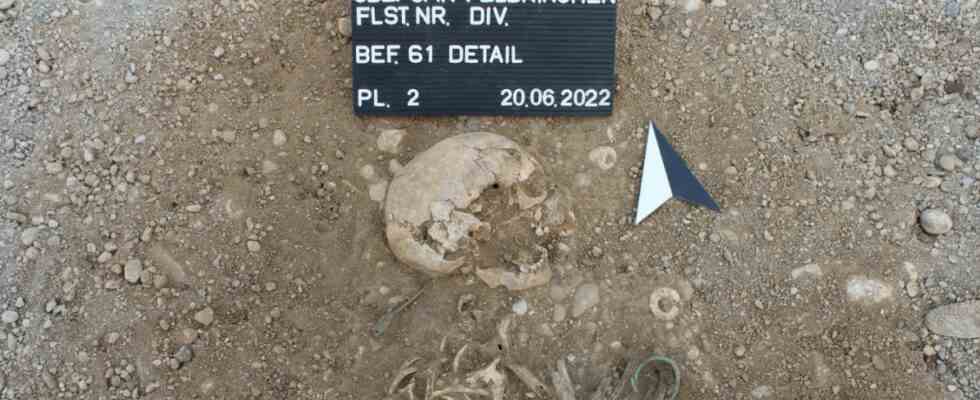Traffic rushes back and forth between Feldkirchen and Messestadt Riem right next to the five-hectare area between the A 94, Münchner Strasse and Ottendichler Strasse, where excavators are currently leveling the area for Bauma’s large temporary car park. You can also hear the motorway clearly from here. If you drive a few meters further, the outlines of the few Munich skyscrapers can be guessed at on the horizon. It is difficult to imagine what it looked like here in the distant past, when there were no cars or multi-storey concrete buildings. But the latest archaeological finds on the site make it more tangible how people could have lived there around 4000 years ago.
During the excavations on the property, many square meters were initially empty, reports archaeologist Birgit Anzenberger from the Anzenberger & Leicht office, which carried out the investigations. “We thought it wouldn’t work anymore.” But then the experts came across the remains of a buried skeleton, and more graves followed. Finally, a few meters away, signs of a settlement were found. According to Anzenberger, both come from the same epoch, the early Bronze Age.
The special thing about the find: The settlement was not built over by later generations, as has often happened in history. “As a result, we have an excerpt from a situation as it actually was at the time,” explains Anzenberger. Archaeologists don’t have to painstakingly pull apart finds from different epochs in order to reconstruct a picture of the past.
The houses were up to 30 meters long
According to Anzenberger, several floor plans of the settlement can be recognized by dark spots in the ground: the earth was excavated there for support posts and later filled in again, which resulted in the discoloration. About half of the twelve floor plans discovered were longhouses that were used for living – according to the archaeologist, the buildings were up to 30 meters long. At that time, people would often have shared the living space in the house with the animals, which were housed in a separate area, says Anzenberger. There were practical reasons for this: on the one hand, the animals would have given off heat in winter, on the other hand, disturbances, for example from an intruding predator, could be noticed immediately.
Among other things, the archaeologists found this decorative pin as grave goods…
(Photo: Birgit Anzenberger/Archaeological Office Anzenberger & Leicht)
… and ornate leg plates.
(Photo: Birgit Anzenberger/Archaeological Office Anzenberger & Leicht)
The blade of a bronze dagger was also unearthed.
(Photo: Birgit Anzenberger/Archaeological Office Anzenberger & Leicht)
About 80 meters from the settlement, nine residents found their last resting place, the excavated skeletal remains allow conclusions to be drawn about two adults and seven children between the ages of one and twelve. Possibly, according to Anzenberger, it was a family. In addition to the buried, rich grave goods came to light – according to Anzenberger, children in particular were given special attention: in their graves, among other things, were decorated leg discs and a decorative pin, and the blade of a small bronze dagger was also unearthed. While one often only finds potsherds and fragments of vases or jugs, a complete ceramic beaker has also been preserved here. “It’s really extraordinary,” says Anzenberger.
A completely preserved ceramic mug is particularly unusual.
(Photo: Birgit Anzenberger/Archaeological Office Anzenberger & Leicht)
According to her assessment, both the settlement and the burial ground were much more extensive than the current excavations show: “There was definitely more in the surrounding areas.” The area around Munich is rich in archaeological finds, and new things from the past are regularly brought to light when the ground is dug up for construction work. The area, which is so popular today, seems to have been a good place for settlements in earlier times. “Life was raging there,” says Anzenberger – even though, according to the archaeologist, the soil was probably not the best. “But there was a very strong increase in the population in the Bronze Age. When there were more people, they eventually had to move to poorer soil.”
In any case, where more than 300 buses will soon be parked during Bauma, life may not have been as good in the long run as Anzenberger suspects. Finally, the lack of development by later generations indicates that the settlers left the area after some time and no new residents returned there. However, according to Anzenberger, a coincidence cannot be ruled out.
Despite the many finds, the distant past still holds countless mysteries: “We only know a fraction of the things that existed back then,” says the archaeologist. Each find could therefore potentially provide important new insights.

